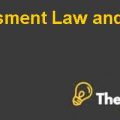Introduction
This paper focuses on the impact of poverty rates on crime rates in the United States, however, after evaluating the country’s economic condition and their impact on crime in each state it can be determined that as the level of poverty increases within the country, it has a significant impact on the crimes. Hence, the level of street crime and other major crimes tends to increase. Furthermore, it was assessed that potential cause of street crime was that the criminal did not have the means to support their families. Additionally, they did not have the required education or experience to secure job, which, in turn, compelled them to resort to criminal activities so that they could provide for their families. However, it was also evaluated that, not all crimes were caused by poverty. Therefore, some criminals looked for the easy way to make money or they had developed a perception that conducting criminal activities to gain instant cash was somehow easier than earning honestly.
Moreover, the gang related criminal activities were also on the rise in the United States. Where, in some states, gang activity was higher as compared to other states in the country.
Therefore, the question at hand was that “does the rise and fall of poverty rates in each state has an impact on the Crime rates of the particular state?”
The impact of poverty on crimes Harvard Case Solution & Analysis
Formation of Model
To determine the relationship between poverty and crime rates of each state, the crime rates have been taken as the dependent variable, which would depend on the poverty rates (independent variable) in each state of the United States. Moreover, a regression model has been developed and illustrated below.
Y = a + bx
Where,
n = Number of observation
Y = Crime rate
X = Poverty rates
Hence, the above model would exhibit the effects of changes in poverty rates on the crime rates of each state in the United States. Additionally, in order to further evaluate the dataset and increase the meaning and worth of the results, a descriptive statistical analysis has been conducted to calculate the mean, standard deviation, kurtosis, standard error and skewness of both variables.
Data Description
The data has been collected for poverty and crime rates of the United States. Furthermore, the data is divided in to 50 states of the U.S with different poverty and crime rate for each of them. Moreover, the data for crime rate by state has been collected from world atlas and the data for poverty rates by state has been collected from United States census bureau. The data collected is illustrated below in exhibit-1.
Exhibit-1
| Sr. No: | State | Poverty rate | Crime Rate |
| 1 | New Hampshire | 0.092 | 1.961 |
| 2 | Maryland | 0.104 | 4.461 |
| 3 | Wyoming | 0.106 | 1.955 |
| 4 | Connecticut | 0.108 | 2.369 |
| 5 | North Dakota | 0.111 | 2.651 |
| 6 | New Jersey | 0.111 | 2.612 |
| 7 | Minnesota | 0.114 | 2.291 |
| 8 | Alaska | 0.114 | 6.358 |
| 9 | Hawaii | 0.115 | 2.592 |
| 10 | Massachusetts | 0.117 | 3.914 |
| 11 | Virginia | 0.118 | 1.962 |
| 12 | Utah | 0.118 | 2.156 |
| 13 | Colorado | 0.121 | 3.091 |
| 14 | Vermont | 0.122 | 0.993 |
This is just a sample partical work. Please place the order on the website to get your own originally done case solution.










